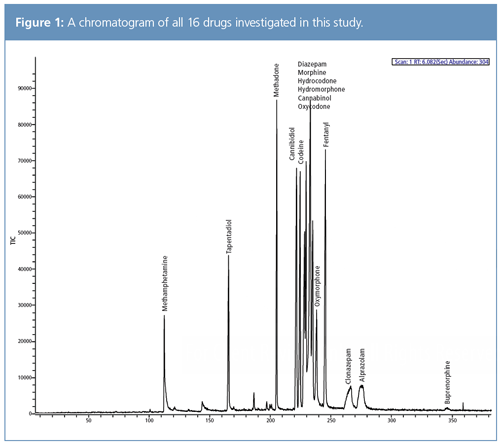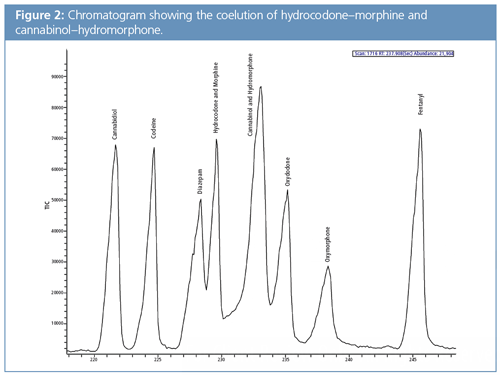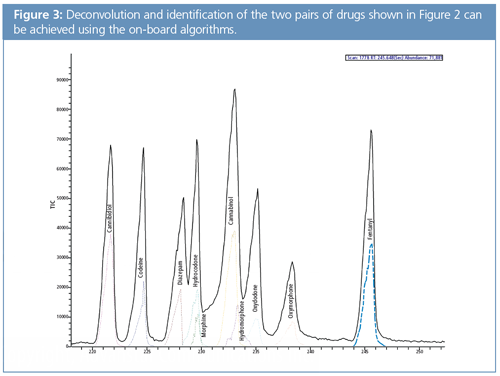Rapid Identification of Illicit Drug Substances Using Thermal Desorption Coupled with a Portable Toroidal Trap GC–MS System
The Column
Recent developments in the miniaturization of gas chromatography–mass spectrometry (GC–MS) instrumentation are making the technique available for field-based investigations, offering a simple, onsite identification of drug substances. This article describes the identification of sixteen drugs compounds in less than 10 min using portable gas chromatograph-toroidal ion trap mass spectrometry combined with a coiled-wire-filament (CWF) sampling injector to provide an effective tool for the rapid analysis of illicit drug substances.
Photo Credit: Kaesler Media/Shutterstock.com

Ramon Soto Alvarez, Ashley Thornock, Serena Michalsky, and David C. Collins, Chemistry Department, Brigham Young University – Idaho, Rexburg, Idaho, USA
Recent developments in the miniaturization of gas chromatography–mass spectrometry (GC–MS) instrumentation are making the technique available for field-based investigations, offering a simple, onsite identification of drug substances. This article describes the identification of sixteen drugs compounds in less than 10 min using portable gas chromatograph-toroidal ion trap mass spectrometry combined with a coiled-wire-filament (CWF) sampling injector to provide an effective tool for the rapid analysis of illicit drug substances.
The misuse of drug substances has created an urgent need to rapidly determine the type of chemical compounds present in the field. Gas chromatography–mass spectrometry (GC–MS) has routinely been used by scientists in the laboratory to characterize the presence of pain medication compounds. Unfortunately, the confirmation process can be extremely slow and time-consuming because the sample must be taken back to the laboratory to perform the analysis. As a result of this limitation, a rapid, on-site solution to the identification and characterization of these compounds is desirable. This study will describe an approach for performing this analysis, using a compact, portable GC–MS system for use by nonspecialist operators in the field.
Methods
The portable GC–MS technology used in this investigation is described in the open literature (1,2). When used in conjunction with an extensive NIST database and custom-built target compound libraries, unknown peaks can be positively identified by nonexperienced personnel in the field (3,4).
Sample Collection: For different sample types, a small, battery-operated, sampling accessory (SPS-3, PerkinElmer Inc.) was available (5), which requires the use of a needle trap (NT) to transfer the analytes to the GC–MS system. Based on the samples being studied, the choice of sampling strategies include:
- Heated headspace (HS) for volatile compounds in solid and liquid samples
- Purge and trap (P&T) for volatiles in liquid (aqueous) samples
- Thermal desorption (TD) for volatiles using a conventional TD tube
- Internal standard (IS) addition module
- The needle trap can also be used independently to sample gases without the sampling module
- Solid-phase microextraction (SPME) can be used for gas and liquid samples
- A coiled wire filament (CWF) is available for semi-volatiles dissolved in solvent samples.
For this study, a CWF sampling accessory was used. A method for the separation and identification of sixteen painkilling drugs using this approach was performed.
Sample Preparation and Analysis: Methanol solutions (1.0 mg/mL) of standard drug substances (methamphetamine, tapentadiol, methadone, cannabidiol, hydrocodone, morphine, hydromorphone, codeine, diazepam, oxycodone, cannabinol, oxymorphone, fentanyl, clonazepam, alprazolam, and buprenorphine) were used (Cerilliant) for the investigation. A single mixture of all sixteen drugs was prepared (60 μg/mL). Prior to injection, and to eliminate backflash of the methanol within the injector of the gas chromatography toroidal mass spectrometer (GC–TMS) system, the sample was first added to a novel deactivated stainless steel CWF (PerkinElmer) with subsequent evaporation of methanol at room temperature and pressure under a fan (1–5 min). Upon introduction of the CWF into the injector of the GC–TMS system, the compounds were thermally desorbed.
The sample was applied to the CWF by the following two methods:
- Direct application of a measured volume using a 10-μL syringe
- Dipping the coil
Direct application using a syringe allowed for known and variable (0.5–10 μL) sample volumes to be applied consistently to the CWF. Larger volumes (5–10 μL) required extended drying time (3–5 min). Dipping resulted in approximately 0.5 μL of sample coating the coil; drying time was consistently 1 min. Once dry, the CWF containing the sample was introduced into the injection port of the GC–TMS system and the coil exposed for 20 s. The gas chromatographic separation conditions and mass spectrometer parameters used for the analysis are detailed below.
Gas Chromatographic Separation Conditions: Sample delivery: coiled wire filament injection; injection type: splitless; split injection times: 50:1 split on: 20 s, 50:1 split off: 60 s; injector temperature: 275 °C; column: 5 m × 0.1 mm, 4-µm MXTâ5 lowâpolarity phase diphenyl dimethyl polysiloxane (Restek); initial temperature and hold time: 40 °C for 20 s; temperature ramp rate: 1.25 °C/s; final temperature and hold time: 300 °C for 147 s; total analysis time: 375 s.
Mass Spectrometer Operating Conditions: Mass spectrometer: Toroidal Ion Trap (PerkinElmer); ionization source: electron impact; MS operating temperature: 160 °C; mass range: 45–500 amu; resolution: <0.5 m/z at 300 amu; MS scan rate: 10–15 scans/s; detector: Electron Multiplier (DeTech).
A custom user-defined compound library was created with individual drug standards to determine drug retention times and mass fragmentation patterns. The library was subsequently used to identify the mixture of sixteen target analytes employing an on-board deconvolution algorithm for the drugs that coeluted.
Results and Discussion
Figure 1 shows a chromatogram of all sixteen drugs when direct application of 5 μL of a drug mixture (60-μg/mL of each drug) was applied to the CWF prior to injection. Twelve of the sixteen drugs had unique retention times and 10 could be separated with baseline resolution.

Although two pairs of drugs (hydrocodone–morphine and cannabinol–hydromorphone) coelute (Figure 2), their mass spectra are significantly different, which can then be deconvoluted and identified using the on-board algorithm, as shown in Figure 3. Under ideal conditions, the whole identification and confirmation process requires approximately 8–10 min.

All sixteen drugs were simultaneously identified with a direct application of 5 μL (~300 ng/drug) to the CWF, as seen in Figure 1. However, this was not possible with dipping the coil in the sample. This is exemplified in Figure 4, which shows a chromatogram of all sixteen drugs when dipping the CWF into a drug mixture (60 μg/mL of each drug).


After separation and deconvolution, only 10–12 of the sixteen drugs could be identified. With this lower amount of sample (~30 ng/drug), signal intensity for fentanyl (~7000), and many other compounds, is approximately 1/10th the signal intensity in Figure 1 (70,000). In fact, the later eluting compounds (clonazepam, alprazolam, and buprenorphine) cannot be seen or identified. In addition, at least one of the lower-intensity compounds (morphine, hydromorphone, and oxymorphone) is unidentified after separation and deconvolution. On the other hand, the dipping technique is much simpler and requires less time, but also requires approximately 10× the concentration of drugs for an equivalent signal. As previously mentioned, it is estimated that ~0.5 μL of the sample is collected on the CWF during dipping.
Conclusion
This study has shown that the preparation, separation, and identification of sixteen common drug substances is possible in the field using a combination of a coiled wire filament sampling device coupled with a gas chromatograph–toroidal ion trap mass spectrometer in under 10 min. This portable, field-based approach has opened up new possibilities for on-site analysis using nonexperienced operators, without having to take samples back to the laboratory for confirmation of the chemical compounds.
References
- J.A. Contreras et al., Journal of American Society of Mass Spectrometry 19(10), 1425–14 (2008).
- T.V. Truong et al., Scientia Chromatographica6(1), 13–26 (2014).
- Torion T-9 Portable GC/MS Product Note, https://www.perkinelmer.com/lab-solutions/resources/ docs/PRD_Torion-T-9-GCMS_012311B_01.pdf
- T.V. Truong, N.L. Porter, E.D. Lee, and R.J. Thomas, Current Trends in Mass Spectrometry14(3), 20–26 (2016).
- SPS-3 Sample Preparation Module for Torion T-9, http://www.perkinelmer.com/lab-solutions/resources/ docs/PRD_Sample_Prep_Station(013095_01).pdf
Ramon Soto Alvarez, Ashley Thornock, and Serena Michalsky are undergraduate students at Brigham Young University, Idaho, USA, who are gaining research experience investigating separation science techniques. Ramon and Ashley are chemistry majors, and Serena is a biochemistry major, who plans to attend medical school.
David C. Collins received a B.S. degree in chemistry at Weber State University (Ogden, Utah, USA) in 1997, and a Ph.D. in analytical chemistry at Brigham Young University (Provo, Utah) in 2001. He has taught both forensic science and chemistry at Weber State University, Colorado State University – Pueblo, and Brigham Young University – Idaho, and has received several teaching awards. In addition, David has written many peer-reviewed articles in separation science and is the author of the forensic science laboratory manual Investigating Chemistry in the Laboratory.
E-mail:collinsd@byui.eduWebsite:www.byui.edu/chemistry/

Determining Enhanced Sensitivity to Odors due to Anxiety-Associated Chemosignals with GC
May 8th 2025Based on their hypothesis that smelling anxiety chemosignals can, like visual anxiety induction, lead to an increase in odor sensitivity, a joint study between the University of Erlangen-Nuremberg (Erlangen, Germany) and the Fraunhofer Institute for Process Engineering and Packaging (Freising, Germany) combined behavioral experiments, odor profile analysis by a trained panel, and instrumental analysis of odorants (gas chromatography-olfactometry) and volatiles (gas chromatography-mass spectrometry).
Investigating 3D-Printable Stationary Phases in Liquid Chromatography
May 7th 20253D printing technology has potential in chromatography, but a major challenge is developing materials with both high porosity and robust mechanical properties. Recently, scientists compared the separation performances of eight different 3D printable stationary phases.
Detecting Hyper-Fast Chromatographic Peaks Using Ion Mobility Spectrometry
May 6th 2025Ion mobility spectrometers can detect trace compounds quickly, though they can face various issues with detecting certain peaks. University of Hannover scientists created a new system for resolving hyper-fast gas chromatography (GC) peaks.

.png&w=3840&q=75)

.png&w=3840&q=75)



.png&w=3840&q=75)



.png&w=3840&q=75)










